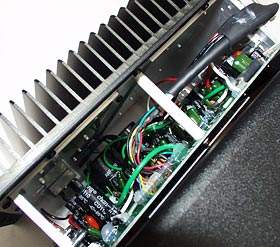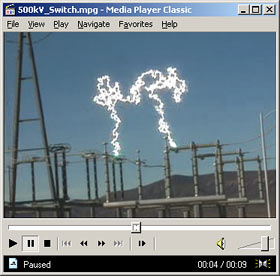
Atomic I/O letters column #54
Originally published in Atomic: Maximum Power Computing Reprinted here February 2006.Last modified 16-Jan-2015.
Rotate computer hourly for best results
Lately I've been looking at HSFs for a new machine and I can't help but notice the seemingly rapid proliferation of heat pipes. It seems they're putting them in everything these days, whether they're needed or not. Kind of like blue LEDs.
Heat pipes rely on phase change (boiling) to transfer heat from the base of the pipe to the top. If a heat pipe cooler is mounted horizontally, this would distribute the liquid through the pipe and it would then have to be less efficient at transferring heat. Most of the pipe coolers I've seen also have the pipes bent upward at a 45 degree angle or so from the base before bending again and going vertically into the main fin assembly, and this would mean that half the pipes would have their liquid sitting in the fins rather than near the source of heat - which would be worse.
So my question is: If I mount a heat pipe HSF in a tower case so that it is sitting horizontally, what sort of performance hit in cooling can I expect, and would I be better off buying a standard non-heat-pipe cooler in such a situation?
There must be some performance hit there.
I don't have the money to do this myself, but maybe someone should take a few of the latest pipe HSFs and mount them on Chernobyl - and test what they do vertically vs. horizontally. It could be an eye-opener.
Daryl
Answer:
You're right, if you're talking about the most basic kind of heat pipe, which is just a sealed tube with some liquid
in it.
Heat pipes made for use in various orientations, though, have a wicking material around the inside of the tube, which allows liquid refrigerant to flow back to the hot end by capillary action.

Heat pipes with a wick can point any way you like, which is why coiled ones work.
Wicked heat pipes aren't as efficient in the vertical orientation as unwicked ones, and wicked pipes also do, indeed, often work not quite as well if they're horizontal or upside down. But the difference isn't large (at least, not for CPU cooling purposes, which are pretty low performance), and there's no liquid-lock problem.
Numerology
A question has plagued my mind for a number of months now. 65536, a seemingly arbitrary number, but why does it come up so much in computing? There are 65536 ports in the Windows OS, 65536 vertical cells in Excel, 65536 PowerPC processors in IBM's Blue Gene/L supercomputer. What is it that makes 65536 a "magic number" in computing? Is it limitations of the 32-bit computing environment, or something deep within the sinister depths of maths and electronics?
Tom
Answer:
It's not an arbitrary number - it's two to the power of 16. 2^16 is the biggest number that can be expressed by two
eight-bit bytes of data (yes, a byte can be some size other than eight
bits - it depends on the computer architecture). So if a programmer assigns two bytes to hold a given positive integer,
whether that integer is a processor address in a supercomputer or a line in a spreadsheet, 65536 will be as big as
it can get.
Powers of two crop up all over computing. 8-bit audio sounds rough because the waveform's jaggied up into only 256 (2^8) steps. A megabyte is 2^20 (1,048,576) bytes (though hard disk manufacturers really want it to be 1,000,000 bytes...). An NTFS volume can hold 4,294,967,295 files (2^32 minus 1). And standard 24 bit colour gives you 16,777,216 (2^24) possible colours.
16-bit colour has, you guessed it, 65536 possible colours.
Two little letters
What does the "PC" in RAM speed ratings stand for? And how does the rating after the PC (for example the 2700 in PC2700) relate to what the RAM is capable of?
Mark
Answer:
I don't think PC stands for anything much (though
opinions differ). If anything, it just indicates that this sort of RAM is for personal computers. It's just some
letters to put in front of the speed rating.
The numbers after the letters are, as you may have noticed, a bit confusing. We can, as usual, thank those upstanding chaps in Marketing for messing up the terminology in their quest to make their company's stuff sound better.
In the olden days before Double Data Rate (DDR) SDRAM, the number after the "PC" was the RAM's bus speed. PC66 RAM was made to run at 66MHz (but might perhaps make it all the way to 83MHz in the hands of the lunatic fringe...), PC100 was 100MHz, PC133 was 133MHz.
Then along came DDR, and Rambus RDRAM.
RDRAM did a great deal for the early success of the Pentium 4 by, for instance, allowing us Australians to buy two 128Mb modules for one thousand eight hundred dollars which was easily four times the price of PC133, at the time.
Rambus memory back then came in "PC600", "PC700" and "PC800" speeds. The numbers indicated the Double Data Rate (DDR) doubled bus speed of the modules, which notably failed, in PC applications, to provide anything like the extra performance you'd expect from a facile bus speed comparison.
And then along came DDR, which was initially named according to its peak bandwidth, which gave even bigger numbers. DDR memory running at a doubled 133MHz clock speed could fairly be called DDR266, and indeed often is these days. But it was initially often called "PC2100", because in theory its bus can move 2100 megabytes per second (rather less, in the real world, as usual).
Them big numbers sounded real purty, so people selling PC100 memory started calling it "PC800", after its peak bus bandwidth. I never noticed anybody calling PC133 RAM "PC1050", but some jackass probably did. These descriptions, of course, overlapped with the RDRAM designators, and there were various and inconsistent decisions to put a space or hyphen in between the PC and the number, as well.
Today, SDR SDRAM is usually named according to bus speed, and DDR often is too, though bandwidth numbers are used interchangeably. RDRAM has exited the PC scene.
(And there was much rejoicing.)
Dark matter?
I think there must be a rift in the space-time continuum causing some kind of particle error when it come to hard drives containing Windows XP.
When I look at the amount of space being used on my C drive it reports having a capacity of 37.2Gb, 26.8Gb being used and 10.3Gb free. However when I select everything on the drive (via Explorer, all hidden files and folders being shown), right click and select Properties, it reports a total size of 15.2Gb.
I know of swap files and such but I didn't think they were in excess of 10Gb, and I've disabled system restore right after installing XP. So where does this extra space go?
Phil
Answer:
Ah, but have you turned off the "Hide protected operating system files" option?
Those files can include a whole lot of stuff - some of which, by the way, you can quite safely delete. WinXP keeps backup files every time you apply a system patch, for instance; they're hidden folders in the Windows directory with names that all start with "$NtUninstall...". If you don't think you're likely to uninstall any of the updates - and you're probably not - then you can delete all of those directories and, if you've never done it before, get back a surprising amount of space on many systems.
AudiUSB
I bought a Xitel INport today. Before I open the box, I'd like to know if it is a USB 2.0 device. Would it make the audio transfer process from an audiophile turntable and preamp any faster if it was? Is there another newer product available that would be a better choice?
Dale
Answer:
The INport uses good old USB 1.1.
Because the INport is a simple stereo-pair line-in device, USB 1 bandwidth is plenty (not that a turntable could play records to it any faster over USB 2, anyway).
USB 1.1 can deliver 12 megabits per second in theory (split between all of the devices on a given root port), and can easily deliver better than three quarters of a megabyte per second of real user data in one direction at any given time. Uncompressed CD quality audio is two channels times 44,100 samples per second times 16 bits per sample, which is 1,411,200 bits per second, 176,400 bytes per second, 0.168 megabytes per second.
If you're talking multitrack 96 kilobit 7.1 channel surround blah blah blah, then it's easy to exceed USB 1.1 bandwidth; full-featured "USB sound cards" these days use USB 2 for a reason. But for a basic stereo pair, the old standard's more than enough.
Back from the dead
I own a set of Logitech Z-560 speakers, but I've lost the controller. There is a 9 pin plug similar to an S-Video connector that plugs into the amp in the subwoofer.
What would be the best way to diagnose the plug to create a wiring diagram? I have a voltmeter and am decent with it.
James
Answer:
Mmm, tricky.
I'd open up the sub, yank the circuit board and see what wire went where. That'd make it easy enough to ID the power and "M3D" terminals, which probably just connect to a simple switch in the remote. The headphone socket wires ought not to be too hard to ID, either. Bass, Fade and Volume are more difficult; telling them apart would be somewhat annoying, and figuring out the right potentiometer values would be worse.
Personally, I'd resign myself to plugging the speakers into a separate amp - easy with the satellites, not very hard with the sub.
And, in closing: FZAT!
Since you like big sparks, I thought you might get a kick out of this vid [link to video clip on personal site, which I'm not giving out to all you yahoos].
Mike
Answer:
I didn't even have to download the clip - I knew which one it'd be.
The best page I've found that provides this and a few other widely-circulated zot-zot-zot clips for download, and explains what's going on in them, is this one.



